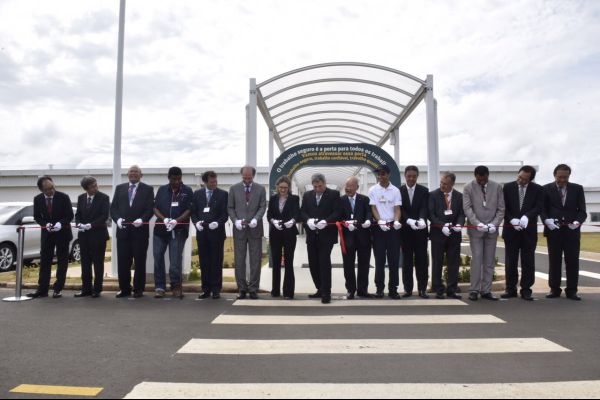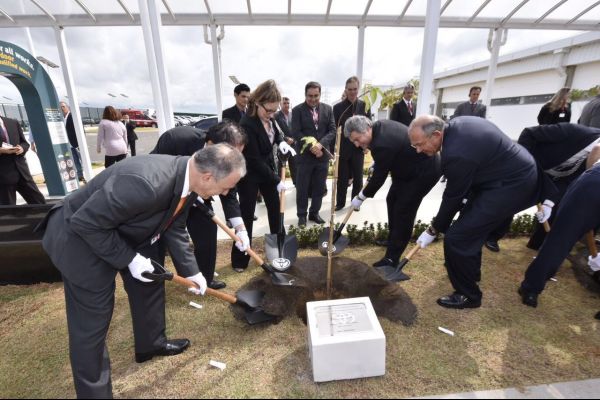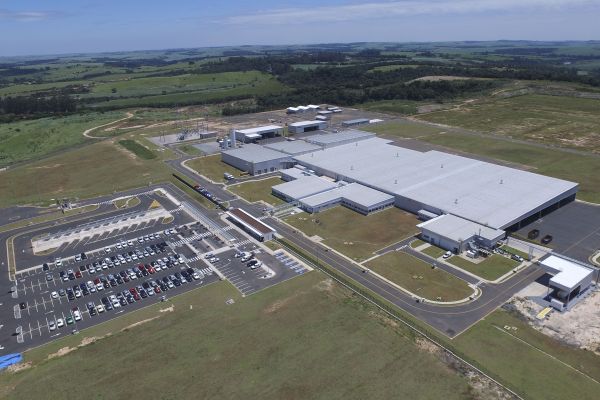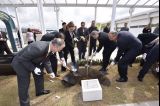Toyota opens engine plant in Porto Feliz
Toyota’s new facilities in the country are the result of an investment of R$ 580 million, employing approximately 320 employees
Investe São PauloOn May10, Toyota do Brasil officially opened its new engine plant in Porto Feliz, São Paulo (SP). The complex covers an area of 872,500 square meters, with an investment of R$ 580 million (18 billion yen), and employs approximately 320 employees.
The project relied on the support from Investe São Paulo, the investment and export promotion agency associated with the Department of Economic Development, Science, Technology and Innovation of the State of São Paulo. “We are happy for having assisted all projects of Toyota in the state, starting with the plant in Sorocaba, which was a success, and finally reaching this new unit,” said the president of the agency, Juan Quirós.
Governor Geraldo Alckmin said that this plant completes the quadrangle of Toyota in the state, also formed by the plants in Indaiatuba, Itu and Sorocaba. He also mentioned the improvements implemented by the state government in the region: “We implemented a vocational school (Etec) in Porto Feliz, which already has 215 students, and doubled Raposo Tavares between the city and Itu. This work will continue up to Tietê.”
With the new facilities, Toyota reinforces its commitment to contribute to society and the economy of Brazil and Latin America and the Caribbean. Toyota’s engine plant also emphasizes the company’s goal to grow sustainably in the region, producing increasingly better cars.
“Brazil will recover, and Toyota is part of this recovery,” said Steve St. Angelo, Toyota’s CEO for Latin America and the Caribbean and Chairman of Toyota do Brasil. The Mayor of Porto Feliz, Levy Rodrigues, thanked the company. “Porto Feliz is experiencing the best moment in its history,” he said.
The plant in Porto Feliz is Toyota’s first engine plant in the region. With an annual capacity of 108 units, it produces modern, efficient and durable 1.3- and 1.5-liter Dual VVT-I four-cylinder flex-fuel and gasoline engines, which equip the compact Etios, produced in Sorocaba and sold in the Brazilian market and exported to other countries in South America: Argentina, Paraguay and Uruguay.
The unit in Porto Feliz has the most advanced and innovative technology in terms of production process, in addition to having a high degree of industrial automation, bringing together high-precision machines within each assembly line stage. To ensure the quality at the end of the process, it features an advanced laboratory for bench testing. All these elements ensure superior quality to the engines produced.
As announced in 2012, Toyota do Brasil has been studying the possibility of producing engines in Porto Feliz to equip the mid-size sedan Corolla.
“Toyota maintains its commitment to growth in Latin America. The plant in Porto Feliz shows that we are doing our part to stimulate the economy of the entire region. On top of our industrial operations in Argentina, Brazil and Venezuela, this new engine unit reaffirms the long-term strategy of Toyota, who sees the potential of Latin America and the Caribbean to emerge as a global economic power in the coming decades,” said St. Angelo.
The start of production of Toyota o Brasil dates back to 1958, with the establishment of the Brazilian unit, the first operation of the automaker outside Japan. Since then, Toyota has fulfilled its goal in the manufacture of vehicles that meet the consumer’s needs, starting with more than 100,000 units of Bandeirante produced and sold between 1958 and 2001. In 1998, Toyota started producing Corolla, continuing with its growth plan in line with the Brazilian market. And, in 2012, it opened a modern plant in Sorocaba, where it produces the compact Etios, in the hatchback and sedan versions.
Toyota do Brasil has also engaged in several environmental initiatives rooted in the community. One of the examples of the importance given by the company to these activities is the Environmental Preservation Project Costa dos Corais, sponsored by Toyota do Brasil, which, among other things, protects the natural habitat of the manatee in the Northeast.
It is also worth mentioning the long-term association of the company, also encompassed by its Foundation, with the Arara Azul project. Among the local projects is the construction and maintenance of a “Green Belt” surrounding its plants, covering a total of 245,000 trees planted in Sorocaba and over 35,000 in Porto Feliz.
“Toyota do Brasil writes a new chapter of its history in the country. Our main mission was not only to build another plant, but to leave a legacy for the Brazilian society. This plant represents how much we believe in the potential of the region and its resilience. As a corporate citizen, Toyota wants to contribute to the development of a future even more prosperous for the domestic industry,” said Koji Kondo, president of Toyota do Brasil.
The engine plant in Porto Feliz is one of Toyota’s first plants to have all three industrial processes within a single location (casting, machining and assembly).
See below the main innovative processes of Toyota’s engine plant in Porto Feliz.
1.Smelting
A large amount of molten aluminum alloy is required during this process. The implementation of modifications to the heat source of the smelting furnace, responsible for the first casting step, allowed a reduction in the equipment size, and consequently, a direct connection with the casting machine, responsible for the second step of the aluminum alloy processing.
Originally, the process required the transportation of molten aluminum from the smelting furnace to the casting machine, which was often marked by a long way.
The result is a marked improvement in terms of safety, as the dangers associated with the transportation of molten metal have been eliminated, since the space required for smelting and casting is significantly smaller, which eliminates the transportation process. Another benefit is the gain in productivity, as the amount of molten metal can now be more readily adjusted to meet the demand.
2. Inorganic sand cores
Cores are devices placed in casting molds to create internal cavities in the final cast component. In this procedure, once molten metal is poured in and has hardened, the cores are broken. Organic additives are traditionally used during casting, due to the need for a combination of ease of disintegration, strength, heat resistance, and casting properties.
However, using cores with organic additives causes tar particles and strong odors to be emitted during the combustion process. This, in turn, requires the use of large dust collectors and deodorizers to remove such by-products. Toyota developed a technique that improves the shaping properties of cores through the use of inorganic matter additives instead of organic matter.
The resulting reduction in the volume of tar particles emitted means that the size of dust collectors can also be reduced. In addition to saving space, this also results in a significant reduction of risks of fire, as well as necessary the maintenance and cleaning of the workplace.
Similarly, the reduction in odor generated also eliminates the need for deodorizers, which further reduces the space designated for casting and thus reduces the initial investment.








